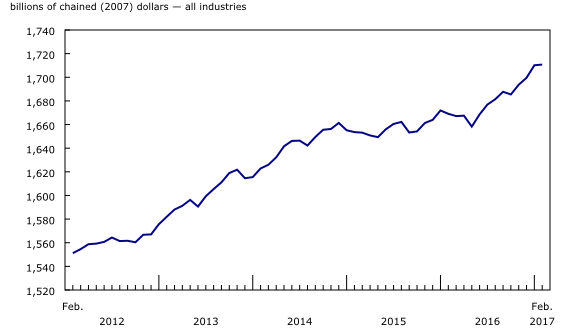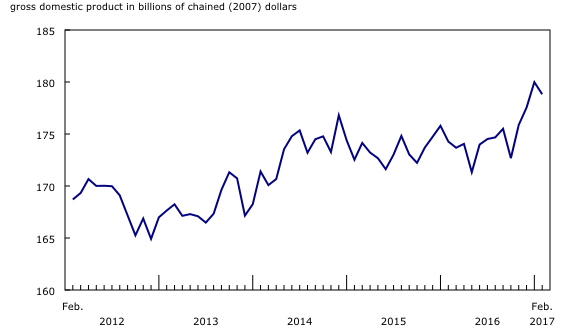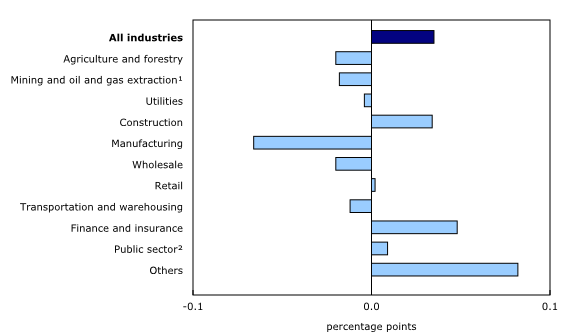Gross domestic product by industry, February 2017
Archived Content
Information identified as archived is provided for reference, research or recordkeeping purposes. It is not subject to the Government of Canada Web Standards and has not been altered or updated since it was archived. Please "contact us" to request a format other than those available.
Released: 2017-04-28
February 2017
0.0% 
(monthly change)
Gross domestic product was unchanged in February following three months of growth. Gains in service-producing industries were offset by declines in goods-producing industries.
Service-producing industries were up 0.2% in February following a 0.5% gain in January, the highest monthly growth rate since January 2013. Goods-producing industries were down for the first time since October, declining 0.3% in February.
The real estate and rental and leasing, finance and insurance sectors both grow
The real estate and rental and leasing sector grew 0.5% in February, led by a 5.3% gain in output of real estate agents and brokers, mainly as a result of notable gains in activity in and around the Greater Toronto Area.
The finance and insurance sector was up for the fourth month in a row, rising 0.7% in February. Depository credit intermediation and monetary authorities were up 0.5%. Financial investment services, funds and other financial vehicles increased 1.4% from higher mutual fund activity related in part to the March 1 deadline for Registered Retirement Savings Plan contributions for the 2016 tax year. Insurance carriers and related activities advanced 0.7%.
Increases in both the real estate and rental and leasing, and finance and insurance sectors contributed to a 2.9% rise in the output of legal services, which was the main contributor to the 0.5% increase in professional, scientific and technical services.
Construction continues to grow
Construction increased for the fourth month in a row, rising 0.5% in February. Engineering and other construction activities increased 0.9% and repair construction grew 0.8%. Residential construction was up 0.3% due in part to more double and row housing construction. Non-residential construction was down 0.5% as industrial, public and commercial construction declined.
The manufacturing sector declines
The manufacturing sector declined 0.6% in February after growing in seven of the previous eight months. The majority of subsectors declined across both durable and non-durable manufacturing.
Durable manufacturing contracted 0.6%, led by lower wood product (-4.5%), transportation equipment (-1.6%) and miscellaneous (-5.0%) manufacturing. In contrast, fabricated metal product (+5.7%) and primary metal (+1.0%) manufacturing increased.
Non-durable manufacturing fell 0.7%, led by decreases in plastic and rubber (-4.3%), chemical (-1.5%) and paper (-1.4%) products. Beverage and tobacco (+3.2%) and food (+0.6%) manufacturing increased.
Mining, quarrying, and oil and gas extraction declines
Mining, quarrying, and oil and gas extraction declined 0.2% in February after growing 2.2% the previous month.
Oil and gas extraction was unchanged in February as lower conventional oil and gas extraction was offset by a gain in non-conventional oil extraction.
Mining and quarrying excluding oil and gas extraction decreased 3.6% in February after four consecutive monthly gains. Metal ore mining declined 2.1%, led by lower activity in copper, nickel, lead and zinc extraction. Non-metallic mineral (-5.6%) and coal (-6.6%) mining also declined. The volume of exports of metal ores and non-metallic minerals was down in February.
Support activities for mining, oil and gas expanded 4.8% in February, continuing a growth sequence that began in the third quarter of 2016 following a slump that began in early 2015.
Wholesale trade declines
Following a 2.1% gain in January, wholesale trade declined 0.4% in February. Seven of nine subsectors recorded losses, while farm product and machinery, equipment and supplies wholesalers increased.
Retail trade is unchanged
The retail sector was unchanged in February after expanding 1.5% in January. Overall, seven of twelve subsectors increased, led by health and personal care stores, clothing and clothing accessories stores and general merchandise stores. Motor vehicle and parts dealers, building material and garden equipment and supplies dealers, and food and beverage stores also recorded declines.
Transportation and warehousing declines
Transportation and warehousing was down 0.3% in February. Rail transportation declined 2.3% as movement of coal, grain and fertilizer products (such as canola and potash), forest products and intermodal freight were all down.
Other industries
Agriculture, forestry, fishing and hunting was down for the fourth time in five months, declining 1.2% in February.
Accommodation and food services were unchanged in February. The increase in food services and drinking places was offset by the drop in accommodation services, which declined for the fifth time in six months.
The utilities sector contracted 0.2% in February as the output of electric power generation, transmission and distribution and natural gas distribution declined.
The public sector (education, health care and public administration) was essentially unchanged.

In celebration of the country's 150th birthday, Statistics Canada is presenting snapshots from our rich statistical history.
Today, we take a look back at the Olympic Winter Games in Canada and their impact on real gross domestic product (GDP) by industry.
The 1988 Winter Olympics, held that year in Calgary from February 13-28, included 46 official events. The 2010 Winter Olympics, held that year in Vancouver from February 12-28, featured 86 official events.
Construction activity related to transportation engineering, and the creation of recreational facilities in Alberta and British Columbia increased GDP. Most of these activities were carried out before the Olympic Games took place. There was also increased activity in other industries, such as food services and drinking places, performing arts and spectator sports, air transportation, and radio and television broadcasting.
Average national growth in February 1988 and 2010 for performing arts, spectator sports and related industries was about 6%, well above the usual growth rate for this series. The number of non-resident tourists entering Canada was also notably higher than usual during these same periods, up about 9%. Radio and television broadcasting also increased. The Vancouver Olympic Games resulted in an increase in output at food services and drinking places, which rose 2.1%, a month-to-month increase that has not been matched since.
Note to readers
Monthly gross domestic product (GDP) by industry data at basic prices are chained volume estimates with 2007 as the reference year. This means that data for each industry and each aggregate are obtained from a chained volume index, multiplied by the industry's value added in 2007. Monthly data are benchmarked to annually chained Fisher volume indexes of GDP obtained from the constant-price supply and use tables (SUT) up to the latest SUT year (2013).
For the period starting with January 2014, data are derived by chaining a fixed-weight Laspeyres volume index to the prior period. The fixed weights are 2013 industry prices.
This approach makes the monthly GDP by industry data more comparable with expenditure-based GDP data, which are chained quarterly.
All data in this release are seasonally adjusted. For information on seasonal adjustment, see Seasonally adjusted data – Frequently asked questions.
For more information on GDP, see the video "What is Gross Domestic Product (GDP)?"
Revisions
With this release of monthly GDP by industry, revisions have been made back to January 2016.
Each month, newly available administrative and survey data from various industries in the economy are integrated and result in statistical revisions. Updated and revised administrative data (including taxation statistics), new information provided by respondents to industry surveys, and standard changes to seasonal adjustment calculations are incorporated with each release.
For more information about monthly national GDP by industry, see the System of Macroeconomic Accounts module on our website.
Real-time CANSIM tables
Real-time CANSIM table 379-8031 will be updated on May 8. For more information, consult the document Real-time CANSIM tables.
Next release
Data on GDP by industry for March will be released on May 31.
Contact information
For more information, contact us (toll-free 1-800-263-1136; 514-283-8300; STATCAN.infostats-infostats.STATCAN@canada.ca).
To enquire about the concepts, methods or data quality of this release, contact Allan Tomas (613-790-6570), Industry Accounts Division.
- Date modified:




